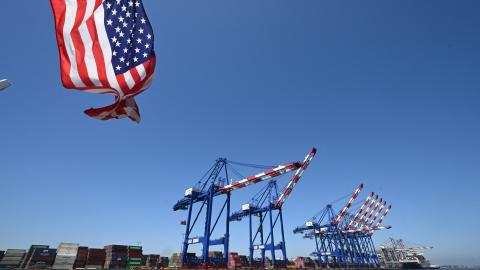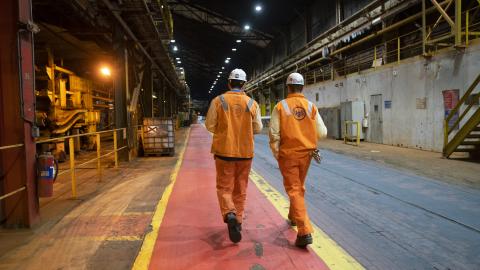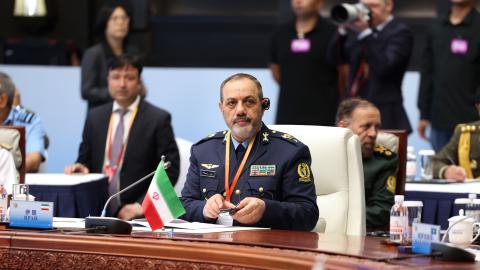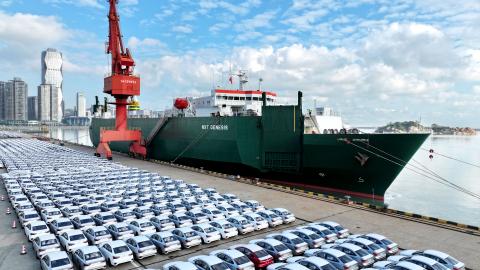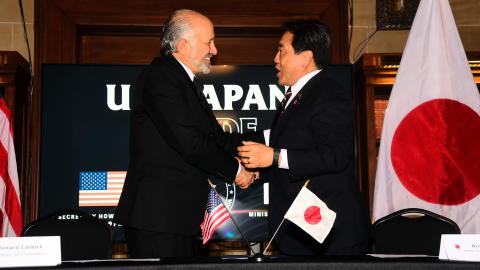When I was at the State Department during my last period of government service, the International Atomic Energy Agency (IAEA) discovered Iran to have been secretly engaging in uranium enrichment experiments, using atomic vapor laser isotope separation (AVLIS) and molecular laser isotope separation (MLIS) techniques, in violation of its safeguards agreement with the IAEA. In fact, not only did Iran conduct such work, but Tehran had advanced further than it originally admitted even after such work was discovered.
Authorities at Iran's Comprehensive Separation Laboratory (CSL) had admitted laser enrichment work in 2003, when dealing with IAEA inspectors sent to Iran after public revelations in late 2002 about its previously entirely secret centrifuge-based enrichment program at Natanz. CSL, however, claimed at first that its laser separation work had onlyenriched small quantities of uranium to about three percent purity of U-235. (While a nuclear weapon can technically be made at levels as low as only 20 percent, that makes a pretty crummy bomb. One is said to need as much as 90 percent U-235 for a usefully small weapon.) This laser enrichment claim turned out to be a lie, however, and in May 2004 the Iranians admitted to enrichment up to about 15 percent, albeit still in small quantities as a research and development effort.
That jump from three to 15 percent is an important difference, inasmuch as the general rule with enrichment is that it gets a lot easier to do the closer one gets to bomb-grade material. It has been estimated, for instance, that fully two-thirds of the isotope separative work needed to make bomb-grade uranium is expended in enriching it from natural-level concentrations of perhaps 0.7 percent U-235 merely to "low enriched uranium" (LEU) levels of 3.6 percent. Onlyone third of the separative work occurs in getting from LEU all the rest of the way to 90 percent, and the remaining work fraction is smaller still if one starts from "highly enriched uranium" (HEU) levels of about 20 percent or greater. Once you've got at least reactor-grade fuel, in other words, you're most of the way to a weapon: it is fairly easy and quick to bump up one's uranium concentrations the rest of the way. (This is why it's so problematic to allow potential proliferators to have fuel-production capabilities. It is also, no doubt, why Tehran is now working so hard to produce a stockpile of LEU and, since February 2010, even uranium at the 20 percent level. Its final sprint to bomb grade material could easily be accomplished by the centrifuges Iran is now moving into a deep mountain tunnel near the holy city of Qom, machines which are already openly earmarked for HEU production.)
Iran told the IAEA that it had discontinued its laser enrichment work. In February 2010, however, President Mahmoud Ahmadinejad, speaking on the 31st anniversary of the Iranian Revolution, announced as his press release put it that thanks to "relentless efforts" by Iranian scientists, the country now "possessed laser enrichment technology" that allowed uranium production "with a higher quality, accuracy, and speed" than with centrifuges. Since then, Iran has refused to answer IAEA inquiries about this claim which, if true, would reveal previous Iranian information given the Agency to be (surprise!) a lie, and which would indicate yet another violation of IAEA safeguards and of multiple legally-binding U.N. Security Council resolutions.
One might think that this Iranian laser pronouncement would occasion widespread outrage, but what seems to have really bothered the international arms control community is the more recent news that the United States apparently now possesses efficient laser enrichment technology. In August of 2010, officials from a consortium led by General Electric and Hitachi claimed to have perfected a laser enrichment technique they call "separation of isotopes by laser excitation" (SILEX), a technology apparently originally developed by Australian scientists. According to GE-Hitachi, this process much of the details of which are apparently classified, as well as being proprietary information promises notable increases in enrichment efficiency, holding out the prospect of providing nuclear fuel more cheaply for a growing global nuclear power industry. The consortium said it had applied for permission from the U.S. Nuclear Regulatory Commission (NRC) to build a SILEX facility near Wilmington, North Carolina.
In contrast to Ahmadinejad's declaration earlier in the same year, the GE-Hitachi announcement about SILEX elicited vocal opposition from arms control and nonproliferation groups. In the words of last weekend's New York Times, "thousands of citizens, supporters of arms control, nuclear experts, and members of Congress" wrote the NRC to urge that the SILEX proposal be rejected. It is not known what the Obama Administration will do, but it clearly seems to be caught between its desire to promote non-fossil-fuel energy sources and its desire to act in conformity with the conventional wisdom of the arms control and nonproliferation community.
To simplify things somewhat, the argument over SILEX seems to be twofold. First, it is argued that going ahead with SILEX in North America will "renew interest" in laser enrichment, leading to its proliferation as a technique around the world that could permit proliferators another alternative for pursuing nuclear weapons development. Second, it is argued that the clandestine use of laser enrichment technology is harder to detect than more traditional centrifuge-based methods of fissile material production, so that the proliferation of MLIS/AVLIS/SILEX technologies will make nuclear cheating easier. Both of these alleged effects stem from the fact that in terms of the amount of uranium enrichment work done per unit of electricity expended, SILEX is said to be more efficient even than the best existing centrifuges. The same efficiency that makes it a more cost-effective system for producing electricity-generating nuclear fuel may allow laser plants to be smaller and use less electricity and hence be less detectable than other types of nuclear fuel production.
I won't take a position on this latter argument here, particularly because whether or not special "signatures" would (or wouldn't) make SILEX detectable seems to be publicly unknowable right now. (GE-Hitachi officials claim that some of the relevant telltales are classified, and a report commissioned on the subject by a former Los Alamos National Laboratory director has not been released.)
I do think it is important, however, to make one point: for better or for worse, the laser cat is to some extent already out of the bag. Let me explain what I mean. It is sometimes the case that a secret technique is most grievously compromised not when its details leak to potential adversaries but rather when the word first gets out merely that such a thing is possible at all. In the intelligence world, I have heard this called a "fact of" compromise, and it can be a bad one. If something is felt to be impossible or impracticable, it may be that no one really worries about someone else doing it. But if this thing is revealed actually to have been achieved after all, this simple fact alone may be all an adversary needs to know enabling him to take countermeasures, or even allowing him eventually to duplicate the capability, since he now knows that it can be done, and there is no need to worry about throwing resources away on a pie-in-the-sky theoretical or conceptual dead end.
Much of the nonproliferation case against SILEX seems to revolve around the idea that, as some of its opponents said in a letter to the NRC, "[s]hould the United States be seen to embrace the use of laser isotope enrichment as a commercially viable technology other states will be strongly encouraged to follow this lead and develop such technology for their own use." To the extent that this is an argument that others will do it simply because we do, however, this strikes me as a weak one. Others will surely pursue laser enrichment based upon their assessment of its value to them, whether or not we do.
The stronger version of that argument is to see SILEX as a "fact of" compromise. Laser enrichment of uranium was previously felt to be an uneconomically inefficient method of producing nuclear fuel. Now that GE-Hitachi has revealed it to be capable of high levels of efficiency, however, others will presumably try to follow. This argument is sound as far as it goes: this "fact of" compromise will probably indeed help "renew interest" in laser enrichment around the world.
But the nonproliferation case built on this foundation may not go as far as its proponents claim, for several reasons. First of all, the "inefficiency" of laser enrichment was never much of a problem for would-be proliferators in the first place. Yes, higher efficiency is certainly preferable, but unless the technology is catastrophically costly and wasteful, sub-optimal efficiency is hardly a showstopper for a nuclear weapons program. For the proliferator, the point isn't to make fissile material particularly economically, but rather just to make it at all.
Indeed, historically, inefficiency has not been felt too much of a problem. Apartheid-era South Africa enriched material for its handful of uranium-intensive nuclear weapons using an obscure method of aerodynamic isotope separation in which gaseous uranium was blown by modified helicopter engines through a special "vortex tube" in such a way that centrifugal force provided the separation work. Its inefficiency was considerable, since aerodynamic enrichment typically consumes something on the order of 4,000 kilowatt-hours of electricity per "separative work unit" (SWU) of uranium enrichment. (That compares very poorly to the 100-150 kilowatt-hours or as little as 50-60 by some accounts needed in centrifuge plants, and even to the 2,000-3,000 required for gaseous diffusion.) But the degree of inefficiency wasn't the point at all. With this aerodynamic system, if one had time, one could build bombs ... and Pretoria did. (Sometimes, moreover, inefficiency can even be an advantage for the proliferator, if it helps throw international verifiers off the track. Before the Gulf War of 1991, no one apparently expected Iraq to be pursuing uranium enrichment using "calutron" electromagnetic isotope separation [EMIS] technology because this was a terribly inefficient method of producing bomb-usable materials. As a result, no one looked for calutrons in Iraq, and the world was shocked after the war to discover how far along Saddam Hussein had actually been in developing his nuclear weapons program.)
News of new efficiencies may make laser work seem even more appealing, but the Iranian example shows that lasers clearly already were attractive: the proliferators were interested anyway. In May 2010, one should also remember, U.S. nuclear scientist and former IAEA inspector Robert Kelley published a report based upon information smuggled out of Burma by a dissident group, in which he detailed alleged efforts by the military junta there to build a nuclear weapons program based in part on MLIS technology. The fact that it was freely acknowledged that no previous laser program had "succeeded in making significant amounts of enriched uranium at anything close to a competitive price" was apparently, for the secretive and paranoid Burmese dictatorship, simply not relevant. Burma thankfully seems to have been nowhere near a breakthrough, but this example should help us keep the current SILEX kerfuffle in perspective. One must not pretend that would-be proliferators didn't care about laser enrichment before GE-Hitachi applied for its NRC permit. They did, and they will likely continue to care no matter what the NRC does.
Efficiency matters a lot when you're talking about producing large quantities of reactor fuel for commercial markets, of course, and GE-Hitachi's revelations about SILEX may indeed spur other countries to undertake new laser enrichment research for commercial power-generation purposes. But this isn't a nonproliferation problem, or at least not directly, or necessarily. The spread of new fissile material production capabilities to countries not presently possessing them, even if in the first instance for peaceful purposes, would present proliferation challenges, and if the SILEX announcement helps lead to this, then there will be much to regret. But the details matter: if the GE-Hitachi revelations simply lead to more efficient and less costly reactor fuel production in existing supplier states, there is little to complain about from a nonproliferation perspective and some reason to be pleased that nuclear power will become less expensive as an alternative to fossil fuels.
In any event, while it is true that there may be consequences from "the public revelation that a half-century of laser failure seems to be ending," most such damage is probably already done. Things might be different if GE-Hitachi had perfected laser enrichment in secret and nobody else had any idea that lasers could work so efficiently. (In that case, there might be an interesting public policy question for the NRC of whether to "out" the SILEX program and reveal that laser enrichment can be tremendously efficient, or whether to shelve the effort quietly and hope no one notices.) But since GE-Hitachi and the New York Times, Global Security Newswire, and other media outlets have already splashed news of SILEX around the world, the "fact of" compromise has already occurred. One should thus now expect other firms and countries to plunge into new laser enrichment research whether or not the NRC approves the GE-Hitachi plan in North Carolina.
Moreover, the conceptual horse may to some extent already have left the barn even before GE-Hitachi went public. As noted, the world has known for some years that Iran had achieved enrichment levels ranging from three to 15 percent in its secret AVLIS experiments during the 1990s. As we have also seen, President Ahmadinejad claimed in early 2010 that Iranian technicians had perfected laser enrichment technology. I'll grant that there are sound reasons not reflexively to trust everything that flies out of that strange man's mouth, and I'm not aware that anything has been publicly released on the kilowatt-hour-per-SWU efficiencies involved even in the older Iranian work that the IAEA discovered. Nevertheless, it is probably unfair to GE-Hitachi to paint the company as having put the issue of laser enrichment back on the global agenda all by themselves. For anyone paying attention, it was to some extent there already. (Even without focusing in any apparent way upon Iran's work, for instance, one study in May 2010 predicted that "[t]he AVLIS method ... will be commercially available in the near future.")
I don't know how all of this will play out, of course, and I take no position here on whether or not the NRC should approve the Wilmington proposal. There are many questions that deserve consideration. Should we, for example, "set a nonproliferation example" even it entails foregoing the non-carbon energy potential of cheaper nuclear fuel? Alternatively, what is that "example" worth, and is it silly to forswear a technology that other nuclear suppliers having now become aware that laser enrichment can work efficiently will now be pursuing anyway, and in which would-be proliferators will remain interested one way or the other? To what extent would proliferating laser technologies indeed undermine IAEA or other verification work, and what would an NRC rejection do to stop its spread now in any event? Is there any way to restrict all fissile-material production technologies to existing fuel producers or to collaborative projects in which technology is not transferred beyond its current geographic reach thus allowing the world to take advantage of improving energy-production efficiencies (such as with SILEX) without spreading the nuclear weapons "option" to additional countries around the globe?
These are difficult questions. In evaluating the potential impact of the GE-Hitachi laser plan and assessing the future of arms control verification in a world of increasing interest in laser enrichment technologies, however, we will need subtler analysis than is provided by knee-jerk horror at new technologies. One hopes the Obama Administration can provide such wisdom.
